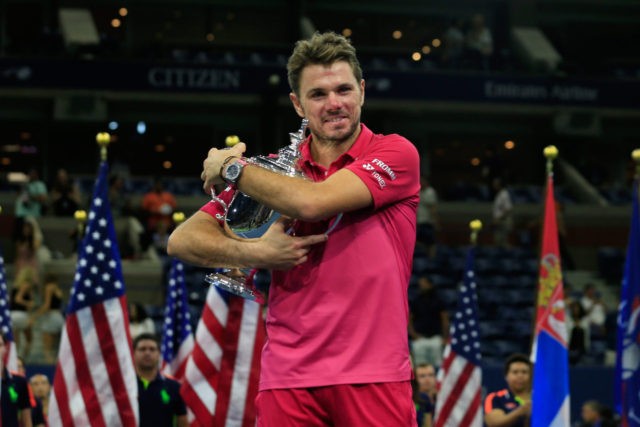NEW YORK CITY — Stan Wawrinka got his gorgeous backhand going early in the second set of the men’s final at the U.S. Open Sunday night. It would be an exaggeration to say it was all smooth sailing from there, but it was the key to victory over the top seeded Novak Djokovic, world number one and defending champ at Flushing Meadows.
When Djokovic took the first-set tiebreak with ease, it seemed not unreasonable to think the Swiss world number three was going to fall short in his bid for a first U.S. Open trophy. Wawrinka was hitting far too many errors.
Wawrinka continued to pile up errors throughout the match – but he began hoarding winners too, with astonishing shots that nicked the sidelines and baselines and left the nimble Djokovic, probably the only man on the tour who can play with the relentless athleticism of France’s Gael Monfils, shaking his head in frustration.
Djokovic beat the French star in the semis the same night Wawrinka wore down Kei Nishikori in a dress rehearsal for Sunday night. In both matches he dropped the first set, only to take the next three with increasingly dominant scores. At 31, Wawrinka may be the toughest, grittiest man on the tour. Roger Federer, absent from this year’s U.S. Open for the first time since 2000 due to knee surgery, dubbed him “Stanimal” years ago, for good reasons, all of which were on display in this final and this tournament.
Wawrinka spent some 18 hours on the courts to get to the final, including a five-setter and three four-setters in a row prior to facing Djokovic in a packed Arthur Ashe Stadium. Djokovic, by contrast, was on the courts only nine hours as his opponents dropped out with injuries. Ironically, Djokovic required two medical time-outs in the fourth set of the final. He stuck it out, visibly limping in the last games. He made no excuses, gave his friend full credit afterwards.
Wawrinka, who stated earlier in the week without a trace of false modesty that he should not be placed at the same level as Djokovic and the others in the “big four” (Roger Federer, Rafa Nadal, and Andy Murray), played his own game, and it worked.
This game, all his rivals have noted, is not confined to the quality Federer suggests with his playful nickname. Wawrinka plays with classically elegant form. He moves with supreme confidence and grace and hits with an accuracy that is breath-taking. Fearless with his deep ground strokes, he has the “soft hands” required of play at the net. Over nearly four hours, he covered more than 14,000 feet, a thousand more than Djokovic. He hit 46 winners to Djokovic’s 30.
Earlier in the day, America’s Bethanie Mattek-Sands won the women’s doubles, teaming with the Czech Republic’s Lucy Safarova, rallying in a thrilling win over the top-seeded French team of Caroline Garcia and Kristina Maldenovic. And young Kayla Day of Santa Barbara won the junior girls’ tournament.
The U.S Open, with its new retractable roof over Ashe and one to follow by 2018 over a rebuilt Louis Armstrong Stadium, had a strong dose of the new this year, with several upsets and a cohort of promising players still in their teens or just out of them. Rafa Nadal was stopped in an epic five-setter by Nicolas Pouille, a nearly unknown 23-year-old Frenchman. Karolina Pliskova beat both Venus and Serena Williams before succumbing in the women’s final to Germany’s Angelique Kerber, who won the Australian Open at the beginning of the year.
But tennis tradition stays strong at Flushing Meadows. The Marine color guard was at its post for the men’s final, splendid as ever on a bitter anniversary. The spectators were asked to commemorate the date with a moment of silence, prior to Norm Lewis’ powerful rendition of the Star Spangled Banner for which, it scarcely needs saying, 25,000 souls stood as one.

COMMENTS
Please let us know if you're having issues with commenting.